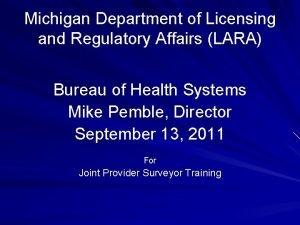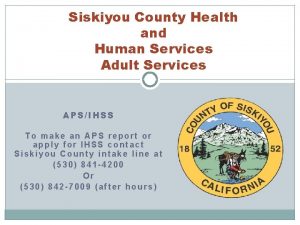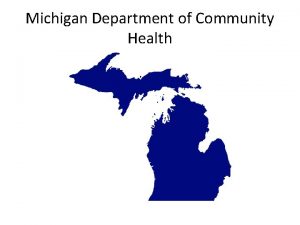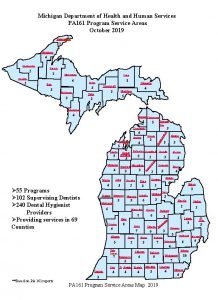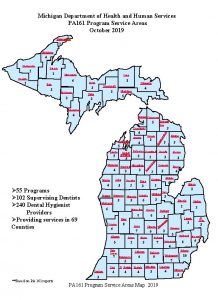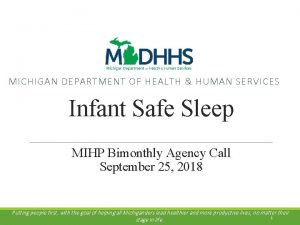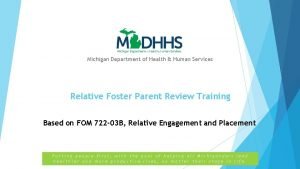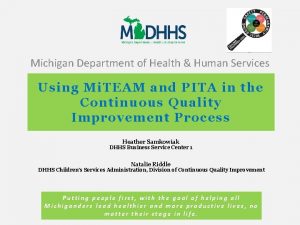Michigan Department of Health and Human Services MDHHS


















- Slides: 18

Michigan Department of Health and Human Services (MDHHS) DEB MACKENZIE-TAYLOR, PHD DIVISION OF ENVIRONMENTAL HEALTH

MDHHS’s Role = Provide Technical Support to Local Health Evaluate potential exposures to environmental chemicals Determine Provide if harm may occur recommendations Outreach to public, healthcare, others

Assessing risk Amount of people’s exposure (dose) Chemical concentrations in environmental media Toxicity of chemicals Risk or hazard from the exposure

Evaluating toxicity of chemicals Evaluation includes: Information from human epidemiology studies May find associations with diseases or cancers Exposure levels have varying levels of uncertainty (dose-response may not be available) Information from laboratory animal studies Do human and laboratory animals have similar health outcomes? Are health outcomes biologically possible in humans? Dose-response data used to develop toxicity values

PFAS Toxicology PFOA and PFOS Used in a wide variety of products in the past Many published studies focusing on these two PFAS Other PFAS Many other per- and polyfluorinated alkyl substances (PFAS) in products and the environment Limited number of published studies on some other PFAS (no studies on others)

Health Outcomes (PFOS and PFOA) In laboratory animals: In people: Alter cholesterol Thyroid Developmental disease (PFOA) Reduce ossification of the proximal phalanges Ulcerative colitis (PFOA) Testicular and kidney cancer Accelerated (PFOA) Alter immune system function effects Decrease pup birth weight puberty in male pups Immune system dysfunction Alter liver and kidney weight

EPA’s Health Advisory Levels Based on reference doses (Rf. D) derived from developmental toxicity study in mice (PFOA) and rats (PFOS) “Lifetime” Health Advisory PFOA + PFOS = 70 ppt (ng/L) Short-term and long-term exposure Protects fetus and others against noncancer health effects (also protective against development of cancer)

More Information Deb Mackenzie-Taylor, Ph. D, MDHHS Toxicology and Response Section Manager 800 -648 -6942 mackenzie-taylord@michigan. gov https: //www. atsdr. cdc. gov/pfc/index. html


Non-Cancer Risk Exposure to an amount higher than the toxicity value (Reference Dose) Exposure equivalent to the toxicity value (Rf. D) Zero Exposure Sensitive populations might be at risk for health effects Increasing Population Risk Minimal Risk Zero Risk

Blood Testing PFAS are in many products commonly used People are expected to have some level of PFAS in their blood Blood testing: CAN tell you the concentration in your blood at time of test CANNOT tell you if current or future health conditions are due to PFAS or how you were exposed (where the PFAS came from)

Blood Levels of the Most Common PFAS in People in the United States from 2000 -2014

Average Blood Level of Some PFAS after Installing a Water Filtration System

Blood Levels in People Who Were Exposed to PFOA Laboratory animal average serum levels that correspond to LOAELS: 12. 4 to 87. 9 milligram/liter (mg/L) (U. S. EPA Health Effects Support Document, Table 4 -8)

Blood Levels in People Who Were Exposed to PFOS Laboratory animal average serum levels that correspond to NOAELs: 6. 26 to 38 milligram/liter (mg/L) LOAELS: 19. 9 to 157 mg/L (U. S. EPA Health Effects Support Document, Table 4 -6)

Individual Risk Will a specific person develop cancer or some other health effects from a chemical exposure? There is no way for us to know. Individual health status best evaluated by a medical doctor Individual risk depends on other exposures, genetics, organ system functioning, health/nutritional status, and other complex parameters.

Population Risk (Example) Population with low or no exposure. Population with elevated exposure. No way to know who would be in the shaded areas. http: //www. arhp. org/publications-and-resources/clinical-proceedings/RHE/Risk

Sequence of Chemical Exposure to Disease Exposure Effects Susceptibility Source Internal Effective Dose Early Molecular Cellular Effects Altered Structure/ Function Clinical Diagnosed Disease Reversible? Measurable? Tissue Organ System Symptoms Cause? Chemical?
 Iowa department of health and human services
Iowa department of health and human services Milwaukee health and human services
Milwaukee health and human services Maine department of health and human services
Maine department of health and human services Washington state department of social and health services
Washington state department of social and health services Department of health and senior services missouri
Department of health and senior services missouri Michigan department of licensing and regulatory affairs
Michigan department of licensing and regulatory affairs Seattle human services department
Seattle human services department Illinois mental health collaborative
Illinois mental health collaborative Delaware county human services
Delaware county human services Ldh health standards
Ldh health standards Health and human services milwaukee
Health and human services milwaukee Siskiyou county human services
Siskiyou county human services Barnstable county human services
Barnstable county human services Michigan department of education teacher certification
Michigan department of education teacher certification Michigan state university physics
Michigan state university physics Wake county human services community services center
Wake county human services community services center Miosha respiratory protection
Miosha respiratory protection Business intelligence services in michigan
Business intelligence services in michigan Lgip services missouri
Lgip services missouri





